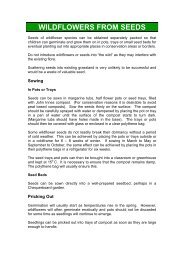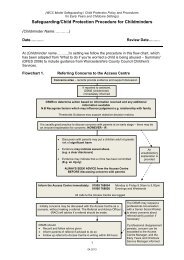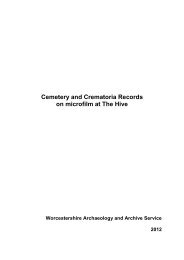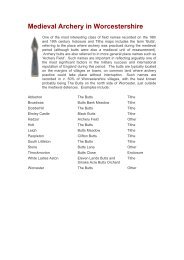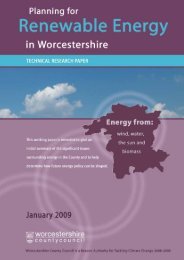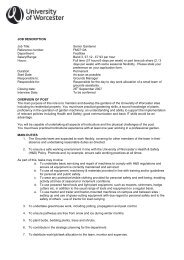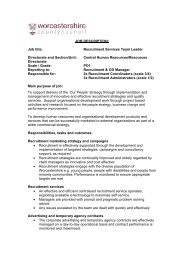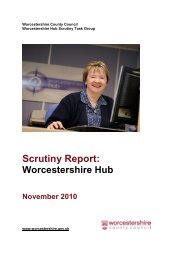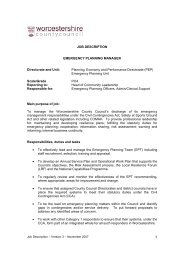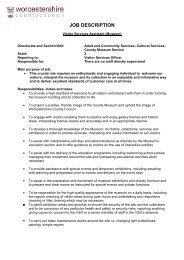Huntsman's Quarry, Kemerton Archaeological investigations ...
Huntsman's Quarry, Kemerton Archaeological investigations ...
Huntsman's Quarry, Kemerton Archaeological investigations ...
Create successful ePaper yourself
Turn your PDF publications into a flip-book with our unique Google optimized e-Paper software.
Huntsman’s <strong>Quarry</strong>, <strong>Kemerton</strong><strong>Archaeological</strong> <strong>investigations</strong> undertaken at Huntsman’s <strong>Quarry</strong>, <strong>Kemerton</strong> insouth Worcestershire during 1995-6 recorded Late Bronze Age occupationareas and field systems spreading across some 8 hectares. Small areas ofearlier prehistoric activity were also identified.Limited evidence for Upper Palaeolithic, Mesolithic and Neolithic activity wasalso recovered. Three closely spaced Beaker pits, along with a scatter of othersimilarly dated features and residual finds provided the first certain evidenceof occupation, while Early Bronze funerary activity was represented by a ringditch.Together with features and finds from the nearby Aston Mill <strong>Quarry</strong>,these provide important evidence of early prehistoric activity in this area.The majority of the deposits were, however, of Late Bronze Age datecomprising waterholes and associated roundhouses, structures and pits setwithin landscape of fields and droveways, elements of which probably predatedthe settlement. Substantial artefactual and ecofactual assemblageswere recovered, mainly from the upper fills within the waterholes and largerpits. The settlement appears to have had a predominantly pastoral economysupported by some textile and bronze production. Ceramics included a notableproportion of non-local fabrics demonstrating that the local populationenjoyed a wide range of regional contacts. Wider ranging, national exchangenetworks were also indicated by the presence of shale objects as well as thesupply of bronze for metalworking, perhaps indicative of a site of some socialstatus. Together the evidence indicates a settlement which can be comparedfavourably to those known along the Thames Valley but until now notrecognised in this part of the country.
Based upon an extensive programme of radiocarbon dating, it is suggestedthat some of the waterholes and elements of the field systems were laid outduring the 12th century BC, areas of settlement being subsequentlyestablished within this “bounded” landscape. These settlement areas appearto have been unenclosed. Dating of charred residues from the substantialplainware assemblage indicates that occupation was focussed in the 11thcentury BC, perhaps spanning as little as four or five generations. It is arguedthat rather than all areas having been contemporaneously occupied, individualareas provided a short-lived focus within a regularly shifting settlement. It issuggested that perhaps this occurred on a generational basis, with eachgeneration setting up a new ‘homestead’ with an associated waterhole.Possibly at the same time, the settlement of the previous generation wasformally abandoned, a process marked by the closure of the waterholes.Slight variations in the composition of the ceramic assemblages across thesite provide some support for this interpretive model.Cropmark evidence and limited other <strong>investigations</strong>, for example at Aston Mill(see Dinn's 1990 report for Worcestershire's <strong>Archaeological</strong> TransactionsJournal) indciate that the fields and droveways represent a small fragment ofa widespread system of boundaries established across the gravel terraceslying between Bredon Hill and the Carrant Brook. This managed and organisedlandscape appears to have been established for the maintenance of aneconomy primarily based on livestock farming; the trackways perhapsfacilitating seasonal movement of stock between meadows alongside theCarrant Brook, on adjacent terraces and on the higher land on Bredon Hill.



